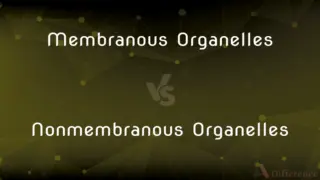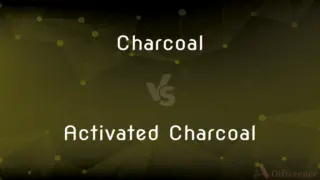Terracotta Plant Pots vs. Ceramic Plant Pots — What's the Difference?
Edited by Tayyaba Rehman — By Fiza Rafique — Published on December 1, 2023
Terracotta Plant Pots are made of baked clay, are porous, and have a reddish-brown color. Ceramic Plant Pots are made from fired clay, often glazed, are less porous, and come in various colors.

Difference Between Terracotta Plant Pots and Ceramic Plant Pots
Table of Contents
ADVERTISEMENT
Key Differences
Terracotta Plant Pots and Ceramic Plant Pots both serve the fundamental purpose of holding plants, but they are distinct in their construction and characteristics. Terracotta Plant Pots are traditionally made from a specific type of clay known for its reddish-brown color. This clay, when baked, becomes porous, allowing for better air and water movement. Ceramic Plant Pots, on the other hand, are made from a variety of clay types and are typically fired at a higher temperature.
When discussing aesthetics, Terracotta Plant Pots usually possess a natural, earthy appearance, making them a favorite for gardeners looking for a rustic touch. Their reddish-brown color complements many plant types. In contrast, Ceramic Plant Pots can be found in a vast array of colors, patterns, and finishes due to the glazing process. This allows for more versatility in matching home or garden decor.
From a maintenance perspective, Terracotta Plant Pots are more breathable, which can be beneficial for plants that prefer drier conditions. However, this also means they can dry out faster. Ceramic Plant Pots, with their glaze, tend to retain moisture longer, making them suitable for plants that thrive in more humid conditions.
The durability of both types of pots is also worth noting. Terracotta Plant Pots, being more porous, can be more susceptible to frost damage or cracking over time. Ceramic Plant Pots, with their harder finish, tend to be more robust, but they can still crack if dropped or exposed to rapid temperature changes.
Lastly, in terms of price, Terracotta Plant Pots tend to be more affordable due to their simpler manufacturing process. Ceramic Plant Pots, with their glazing and decorative elements, can be pricier, depending on their design and craftsmanship.
ADVERTISEMENT
Comparison Chart
Material
Made from specific reddish-brown clay.
Made from various types of clay.
Porosity
Porous, allows better air and water movement.
Less porous due to glazing, retains moisture.
Appearance
Natural, rustic, reddish-brown color.
Various colors, patterns, and finishes.
Durability
Susceptible to frost damage, can crack over time.
More robust but can crack with rapid temperature changes.
Price
Generally more affordable.
Can be pricier due to design and craftsmanship.
Compare with Definitions
Terracotta Plant Pots
Plant containers crafted from reddish-brown clay.
I placed the succulent in a Terracotta Plant Pot for a natural look.
Ceramic Plant Pots
Hard, often decorative pots suitable for various plants.
The vibrant colors of the Ceramic Plant Pots added charm to the balcony.
Terracotta Plant Pots
Earthy, rustic pots made from baked clay.
The herb garden looked beautiful with Terracotta Plant Pots lined up.
Ceramic Plant Pots
Non-porous plant containers available in many designs.
The Ceramic Plant Pot retained water, making it ideal for ferns.
Terracotta Plant Pots
Un-glazed pots with a natural clay texture.
The moisture evaporated quickly from the Terracotta Plant Pot.
Ceramic Plant Pots
Durable containers often used for indoor plants.
The snake plant was placed in a sleek Ceramic Plant Pot for the living room.
Terracotta Plant Pots
Traditional plant holders often seen in Mediterranean style gardens.
The olive tree was perfectly complemented by its Terracotta Plant Pot.
Ceramic Plant Pots
Pots made from fired clay, often with a glazed finish.
The orchid looked elegant in its Ceramic Plant Pot.
Terracotta Plant Pots
Porous clay pots suitable for plants needing dry conditions.
The cactus thrived in the Terracotta Plant Pot.
Ceramic Plant Pots
Plant holders fired at high temperatures to achieve a hard finish.
I chose a Ceramic Plant Pot for its longevity and design.
Common Curiosities
Why are Terracotta Plant Pots porous?
They are made from baked clay without a glaze, allowing for air and water movement.
Are Ceramic Plant Pots suitable for plants that need more moisture?
Yes, due to their less porous nature, they retain moisture longer.
Which type of pot is more durable?
Ceramic Plant Pots tend to be more durable, but both types can crack under certain conditions.
Can Ceramic Plant Pots come in different colors?
Yes, they can come in a variety of colors, patterns, and finishes.
Which pot type has a more natural, earthy appearance?
Terracotta Plant Pots have a more natural, reddish-brown appearance.
Do Terracotta Plant Pots dry out faster?
Yes, their porous nature allows for faster evaporation.
Are Terracotta Plant Pots more affordable?
Generally, yes. They tend to be more cost-effective than many Ceramic Plant Pots.
Can Ceramic Plant Pots be used outdoors?
Yes, but it's essential to consider rapid temperature changes which might cause cracking.
How do Ceramic Plant Pots differ in material?
Ceramic Plant Pots are made from various types of clay and often have a glazed finish.
Why are some Ceramic Plant Pots pricier?
They can be pricier due to their design, craftsmanship, and glazing process.
What are Terracotta Plant Pots made from?
Terracotta Plant Pots are made from specific reddish-brown clay.
Which pot type is better for succulents?
Terracotta Plant Pots are often preferred for succulents due to their breathability.
Is frost damage a concern for Terracotta Plant Pots?
Yes, being more porous, they can be susceptible to frost damage.
Can both pot types be used for indoor plants?
Yes, both Terracotta Plant Pots and Ceramic Plant Pots are suitable for indoor use, but it's essential to match the pot to the plant's needs.
How should I choose between the two pot types?
Consider the plant's needs, your aesthetic preference, and the pot's location.
Share Your Discovery

Previous Comparison
Alpha Amylase vs. Beta Amylase
Next Comparison
Membranous Organelles vs. Nonmembranous OrganellesAuthor Spotlight
Written by
Fiza RafiqueFiza Rafique is a skilled content writer at AskDifference.com, where she meticulously refines and enhances written pieces. Drawing from her vast editorial expertise, Fiza ensures clarity, accuracy, and precision in every article. Passionate about language, she continually seeks to elevate the quality of content for readers worldwide.
Edited by
Tayyaba RehmanTayyaba Rehman is a distinguished writer, currently serving as a primary contributor to askdifference.com. As a researcher in semantics and etymology, Tayyaba's passion for the complexity of languages and their distinctions has found a perfect home on the platform. Tayyaba delves into the intricacies of language, distinguishing between commonly confused words and phrases, thereby providing clarity for readers worldwide.











































